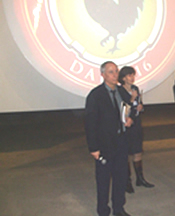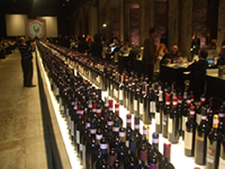The new law delinking Chianti Classico from the much bigger Chianti region completely was officially announced by Marco Pallanti, the President of Consortium at the Chianti Classico Collection 2010 held at the old Leopolda station in Florence on 16 and 17 February, generating a mixed response. Subhash Arora reports.
 Normally, the ultimate divorce between the two regions, would bring joy to the area producers. However, the reaction has varied from cautious optimism to downright cynicism. The law may accord an implicitly higher quality status to Chianti Classico, but it may not result in immediate increase in sales or the unique differentiation factor that the Classico producers are so proud of. Normally, the ultimate divorce between the two regions, would bring joy to the area producers. However, the reaction has varied from cautious optimism to downright cynicism. The law may accord an implicitly higher quality status to Chianti Classico, but it may not result in immediate increase in sales or the unique differentiation factor that the Classico producers are so proud of.
The inability of the average Indian wine connoisseur to give the due respect to the Classico appears to be also a universal problem. Although no one at the annual event of Ante Prima tasting for the Chianti Classico wines in the Tuscan capital doubted that the wine connoisseurs understood and appreciated the Classico wines better, most producers rued that while buying, the customer does not give the due recognition and instead buys the cheaper quality Chianti because of the cost factor.
To be sure, Chianti Classico has set tighter standards than Chianti, tightened further by the recent qualification that also stipulates that Chianti wine will no longer be allowed to be produced in the Chianti Classico region. Earlier, if the quality of wine was not up to the mark, its producer had the liberty to label and sell it as Chianti. However, the latest ruling bans this practice and the Consorzio believes this will further improve the quality.
Besides the area considered superior in terms of territory and soil, Classico producers must use 80% Sangiovese with 20% of other red grapes, whereas Chianti may use only 70% Sangiovese and also white grapes like Terbbiano (10%), a practice frowned upon by the Classico producers. It also does not allow the use of the word ‘Superiore’ which is loosely defined by Chianti and is used more to create an impression of better quality.
Chianti Classico proponents also concede that there may be some parts or wineries in Chianti which make very good quality wine but insist that the average quality is lower. Patrizia Cantini, a Florence based wine journalist concurs, saying she loves Chianti from Ruffina which is cheaper, as also from a few other producers from the 5 Chianti areas , but in general Classico are better but more expensive.
Here the balance tips in Chianti’s favour. Prices of Chianti are around 30-40% lower than Chianti Classico, though some premium Chianti wines may be more expensive than many in the latter denomination. The President of the Consorzio, Marco Pallanti who also owns Castello di Ama, one of the top quality Classico estates, said in the seminar about the US Market for Chianti Classico that it was impossible to think of bringing down the cost of a Chianti Classico to less than € 4.50 a bottle ex-cellar, whereas it is not impossible to find a Chianti for half the price.
Not only are the Chianti producers taking advantage of the Classico quality image but are able to sell in bigger numbers due to the price advantage.
Speaker after every speaker at the seminar emphasized that the average retail or the restaurant consumer in the US or even in Italy neither knew, not cared about the difference between the two; he orders more of Chianti because of the cheaper price. The CC market for connoisseurs is rather limited in the US- a fact which is even more visible in the Indian market.
Wine experts agree on the higher quality of Classico. In 2008, Felsina Chianti Classico Berardenga 2006 with 100% Sangiovese, made it to the Top 100  selection of Wine Spectator wines-it was the top Italian wine in the list. Recently in 2009, Castello di Brolio Chianti Classico 2006 from Barone Ricasoli Estate, breached the levels of quality and was number 5 in Top 100, creating a history of sorts, according to the owner, Baron Francesco Ricasoli who claims the Chianti Classico in general and his estate in particular, keep on striving for better quality in order to compete better with the cheaper counterparts. This was despite the fact that the wine is listed at $54 in the list which gives higher weight to lower priced wines. selection of Wine Spectator wines-it was the top Italian wine in the list. Recently in 2009, Castello di Brolio Chianti Classico 2006 from Barone Ricasoli Estate, breached the levels of quality and was number 5 in Top 100, creating a history of sorts, according to the owner, Baron Francesco Ricasoli who claims the Chianti Classico in general and his estate in particular, keep on striving for better quality in order to compete better with the cheaper counterparts. This was despite the fact that the wine is listed at $54 in the list which gives higher weight to lower priced wines.
Felsina is being imported by Amfora Wines who have not been very successful in converting the coveted label into volume sales whereas Mohan Bros. who import the Barone Ricasoli have made a marginal improvement in their sales last year- though before the wine made it to the Top 100 list.
There has been downward price pressure on Chianti Classico last year because of recession. This has reduced the gap somewhat, but Chianti prices have been sliding too. General consensus at the seminar as well as the producers was that the Classico has to continue to build a better brand image; Chianti Classico Collection and holding of such seminars is one such avenue.
And if the organisation of the event were directly related to the wine quality, it would be difficult for Chianti to match Chianti Classico
Chianti Classico Collection 2010
There were about 140 producers who offered their 2009 for ante prima tasting (barrel samples). The 2008 –many of whom were still not released and 2007 vintages were tasted on an individual sommelier service basis as well as with the producers at the tables. The 2007 vintage is perceived to be almost as good as the 2006 vintage which overshadowed the reputation of the earlier 2004 vintage. But if one could generalize, based on the present day of drinkability, the 2006 still reigns supreme.
Classico Riserva 2006 is almost ready to drink with the tannins having been tamed into the juicy form. It was not possible to generalize the 2009 vintage, from the barrel tasting.
Chianti Classico is no doubt a serious wine and can handle the heartiest of meals like game, roast, steaks etc. but the producer and vintage will continue to make the difference. Their 5-times bigger, Chianti cousins will continue to harp on the fact that they are as good though cheaper (which is a less convincing argument). Meanwhile, for the wine connoisseurs and those who can afford it, pleasure is waiting in that bottle of Chianti Classico…
...with a Black Rooster on the pink neck of the bottle.
Subhash Arora |